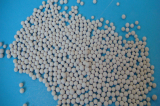MOLECULAR SIEVES Suppliers, MOLECULAR SIEVES Manufacturers.

Molecular Sieves
Molecular sieve is a material containing tiny pores of a precise and uniform size that is used as an absorbent for gases and liquids.
Molecules small enough to pass through the pores are absorbed while larger molecules are not. It is different from a common filter
in that it operates on a molecular level. For instance, a water molecule may not be small enough to pass through while the smaller
molecules in the gas pass through. Because of this, they often function as a desiccant. A molecular sieve can adsorb water up to
22% of its own weight.
Often they consist of aluminosilicate minerals, clays, porous glasses, microporous charcoals, zeolites, active carbons, or synthetic
compounds that have open structures through which small molecules, such as nitrogen and water can diffuse.
Molecular sieves are often utilized in the petroleum industry, especially for the purification of gas streams and in the chemistry
laboratory for separating compounds and drying reaction starting materials. The mercury content of natural gas is extremely harmful
to the aluminium piping and other parts of the liquefaction apparatus - silica gel is used in this case.
Methods for regeneration of molecular sieves include pressure change (as in oxygen concentrators), heating and purging with a carrier
gas (as when used in ethanol dehydration), or heating under high vacuum.
§ 3A (pore size 3 Å): Adsorbs NH3, H2O, (not C2H6), good for drying polar liquids.
§ 4A (pore size 4 Å): Adsorbs H2O, CO2, SO2, H2S, C2H4, C2H6, C3H6, EtOH. Will not adsorb C3H8 and higher hydrocarbons.
Good for drying nonpolar liquids and gases.
§ 5A (pore size 5 Å): Adsorbs normal (linear) hydrocarbons to n-C4H10, alcohols to C4H9OH, mercaptans to C4H9SH. Will not adsorb isocompounds or rings greater than C4.
§ 10X (pore size 8 Å): Adsorbs branched hydrocarbons and aromatics. Useful for drying gases.
§ 13X (pore size 10 Å): Adsorbs di-n-butylamine (not tri-n-butylamine). Useful for drying
Company: |
Pingxiang Global Chemical Packing Co.,Ltd. |
Contact: |
Amanda Kuang |
Phone: |
+86-799-6376388 |
Mobile phone: |
15932889062 |
Fax: |
+86-799-6375200 |
E-mail: |
hzb@pxhq.cn |
Website:
|
http://www.pxhq.cn |
Address: |
Anyuan Industrial Park, Pingxiang, Jiangxi,China |
Zip Code: |
337000 |